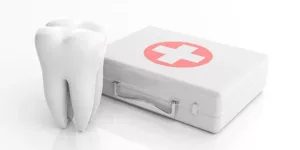Oral First Aid Kit
(Before we start: oral health and dental emergencies are emergencies, and first aid is meant to be the initial step in controlling the damage. If the worst should occur, contact your dentist or local emergency room right away to get substantive care)
As we’ve all learned over the last year and a half, preparedness is critical in ensuring both success and comfort should the worst happen. And while we all know that having a first aid kit at home is an absolute must, most first aid kits don’t include much if anything in the way of oral first aid gear. That’s a shame; while dental first aid emergencies are rare they do happen and we need to be ready for them. So in lieu of a commercially produced oral first aid kit, how can we best put together an oral first aid kit at home? Let’s take a look at some of the things you’ll need in an oral first aid kit and what they’re used for.
The first set of items you’ll need in an oral first aid kit are those that allow you to assess the situation and see what damage has occurred. These include disposable medical gloves–we recommend non-latex as some people are allergic. These are the gloves your doctor and dentist wear while examining you, and they protect both the person performing the exam and the patient from infection or contamination. Put them on before performing any oral first aid. The next item on the list is a dental mirror, just like the one your dentist uses. They’re inexpensive and they’ll allow you to take a more thorough look into the nooks and crannies of the mouth to assess what’s going on. Finally, some disinfectant alcohol wipes and saline rinses can help clear away dirt and debris from a wound or damaged area, and the alcohol wipes can help disinfect an injury.
The next set of items you’ll want in an oral first aid kit are intended to help treat and control a wound or injury. Medical cotton balls, cotton swabs, and gauze are all necessary supplies for an oral first aid kit. They can be used to clear debris or blood away in order to perform an initial assessment, and cotton balls and gauze can be used to control bleeding, pack a wound, or fill a socket for a dislodged tooth. They’re cheap and available at most pharmacies or drug stores, so make sure to add some to your oral first aid kit. Salt or a pre-made oral saline solution is again a must to flush out any debris and help clean and sterilize the site of a wound or injury. And while it may seem obvious, dental floss is a must in a dental first aid kit. With dental floss, you can remove stuck food, debris, or tissue from between the teeth. These are commonplace dental emergencies and should not be overlooked.
The final set of supplies we’ll look at are those intended to control or prevent pain. Dental wax is sold at most drug stores to lessen the irritation from braces. It can be used in your dental first aid kit to cover broken braces and wires, the jagged edges of a chipped or broken tooth, or any of a number of sources of irritation. Topical painkillers and over-the-counter pain meds can take the edge off the discomfort caused by an oral injury, so include them as well. A cold pack is a great way to reduce discomfort and swelling should a dental emergency occur, so adding one to your dental first aid kit is a must. Finally, filling and crown repair kits are available in most pharmacies or drug stores, and they can provide temporary relief should a filling or crown be dislodged.
Again, first aid is often just a temporary measure. For any dental emergency or serious oral injury, contact your dentist or emergency room right away. And if it’s time for more routine oral health care–say an exam and cleaning–get in touch with us today. Our friendly staff will make an appointment and get you in to see us for whatever you need.
